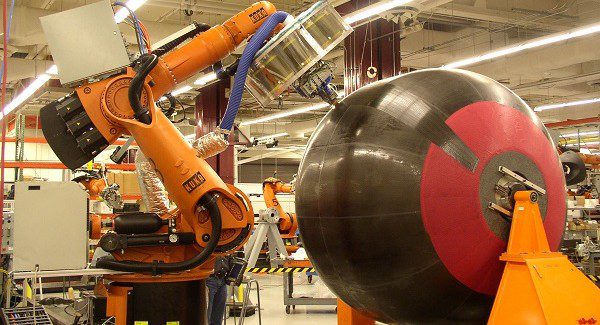Automated Composite Structure Inspection Moves Forward
Inspections occur in real-time during fabrication of the composite structure, alerting the operator and detecting and repairing defects and anomalies during fabrication.
Posted: November 4, 2015
The National Center for Defense Manufacturing and Machining (NCDMM; Blairsville, PA) in partnership with Ingersoll Machine Tools, Inc. (Rockford, IL) and Orbital ATK Inc. (Dulles, VA), has announced the successful completion of Phase I of a three-year project to develop an automated inspection system for the Air Force Research Laboratory (AFRL) at Wright-Patterson Air Force Base (AFB) in Ohio funded through the defense-wide Manufacturing Science and Technology (DMS&T) program.
The newly developed Automated Composite Structure Inspection System (ACSIS) achieved an impressive defect detection rate of up to 99.7 percent in aircraft components produced by automated fiber placement (AFP) that featured varying geometries, ranging from flat to complex.
Widely used by both military and commercial aerospace programs, AFP is a repeatable, cost-effective composite structure fabrication method. AFP uses strips of composite material impregnated with a resin commonly referred to as tows. During AFP, groups of tows are deposited onto a tool by an AFP machine to form plies that create a composite structure. While AFP machines are designed and programmed for proper placement of the tows during fabrication, potential problems inherent to composite production can occur. As such, production is interrupted after each ply to manually inspect the fibers against a stringent set of criteria.
ACSIS represents a significant step forward from the current manual AFP inspection practice, which is extremely time consuming, laborious, and visually tedious as defects are difficult to discern. With ACSIS, inspections occur in real-time while the composite structure is being fabricated, alerting the operator and allowing defects and anomalies to be detected and repaired during the fabrication process. The developed system also includes an electronic database system to electronically document and track defects.
“On behalf of all of us here, we are incredibly proud of the development of an automated inspection system that is capable of attaining such accurate rates of defect detection and improving high-speed AFP operations,” said Jim Fisher, the director of operations at NCDMM. “Within the industry, developing an automated inspection system has been attempted in the past without much success. We had strong partnering on this project that produced a very collaborative dynamic, which is one of the reasons for the outstanding results. ACSIS was proven in a very difficult production environment and we could not be more pleased with the success of Phase I. We look forward to Phase II producing a similar outcome.”
NCDMM was awarded the effort to oversee the development of an automated system as part of a 2012 DMS&T program through the AFRL at Wright-Patterson AFB. For Phase I, NCDMM initially worked with Ingersoll Machine Tools in the development of an on-tool inspection system. Then, they partnered with Orbital ATK for the beta site implementation testing of the ACSIS, developed by Ingersoll Machine Tools, during AFP production.
“We are extremely pleased with the tremendous progress that the ACSIS team made in Phase I,” said Tino Oldani, the president and chief executive officer of Ingersoll Machine Tools. “Led by NCDMM, the team approach allowed us to go above and beyond our goals while adhering to an aggressive schedule. Testing the system at Orbital ATK in a production environment was crucial to the success and prove-out of this first phase. We are looking forward to working with the entire team again to further refine ACSIS in Phase II.”
In the spring of 2015, ACSIS was installed as a standalone system, independent of an AFP machine into the production environment of F-35 Joint Strike Fighter nacelles at Orbital ATK’s Clearfield, Utah facility. ACSIS was tested and compared side by side with the baseline manual inspection process, identifying such defects as missing or twisted tows; gaps between tows; inaccurately placed tows; bridging, wrinkles, or splices; and foreign objects and debris. After eight weeks in production scanning .125 in BMI material on the F-35 nacelles, the ACSIS inspected 54 plies, resulting in a defect detection rate, ranging between 98.4 percent to 99.7 percent, and a false positive rate, of 0.1 percent to 0.2 percent, with both rates well within the acceptable range for a production environment.
“We appreciate the opportunity to work with NCDMM and Ingersoll Machine Tools on this project, providing unbiased, real-world testing of the ACSIS hardware and software in a production environment,” said Bert Vanderheiden, the vice president of military structures at Orbital ATK Aerospace Structures Division. “Given our extensive experience with AFP, we believe ACSIS shows great promise for transition and commercialization within the aerospace industry. ACSIS has demonstrated the ability to reliably detect defects, and with planned future phase improvements, this technology will support higher speed AFP operations.”
With additional funding from DMS&T and AFRL, Phase II of the ACSIS project recently kicked off. Enhancements are underway to further refine ACSIS in order to move it closer to implementation and transition in both military and commercial markets.











